| کد مقاله | کد نشریه | سال انتشار | مقاله انگلیسی | نسخه تمام متن |
|---|---|---|---|---|
| 5594389 | 1571428 | 2017 | 10 صفحه PDF | دانلود رایگان |

BackgroundDecisions to use rhythm control in atrial fibrillation (AF) should generally be dictated by patient factors, such as quality of life, heart failure, and other comorbidities. Whether or not other factors affect decisions about the use of rhythm control, and catheter ablation in particular, is unknown.MethodsA cohort of all patients diagnosed with nonvalvular AF were identified from the National Cardiovascular Data Registry's Practice Innovation and Clinical Excellence (PINNACLE) AF registry of US outpatient cardiology practices during the study period from May 1, 2008, to December 31, 2014. Overall and practice-specific rates of rhythm control (cardioversion, antiarrhythmic drug therapy, or catheter ablation) were assessed. We assessed patient and practice factors associated with rhythm control and determined the relative contribution of patient, practice, and unmeasured practice factors with its use.ResultsAmong 511,958 PINNACLE AF patients, 22.3% were treated with rhythm control and 2.9% underwent catheter ablation. Significant practice variation in rhythm control was present (median rate of rhythm control across practices 22.8%, range 0.2%-62.9%). Significant patient factors associated with rhythm control therapy included white (vs nonwhite) race (odds ratio [OR] 2.43, PÂ <Â .001), private (vs nonprivate) insurance (OR 1.04, PÂ <Â .001), and whether a patient was seen by an electrophysiologist (OR 1.77, PÂ <Â .001). In an analysis of the relative contribution of patient, practice, and unmeasured practice factors with rhythm control, the contribution of unmeasured practice factors (95% range OR 0.29-3.44) exceeded that of either patient (95% range OR 0.46-2.30) or practice (95% range OR 0.15-2.77) factors.ConclusionsOne in 5 AF patients in the PINNACLE registry received rhythm control, and 1 in 50 received catheter ablation, suggesting that rhythm control may be underused. A variety of measured and unmeasured practice factors unrelated to patient characteristics play a disproportionate role in the use of rhythm control treatment decisions. Understanding the drivers of these decisions may identify inappropriate treatment variation and better inform optimal use of these therapies.
Journal: American Heart Journal - Volume 187, May 2017, Pages 88-97